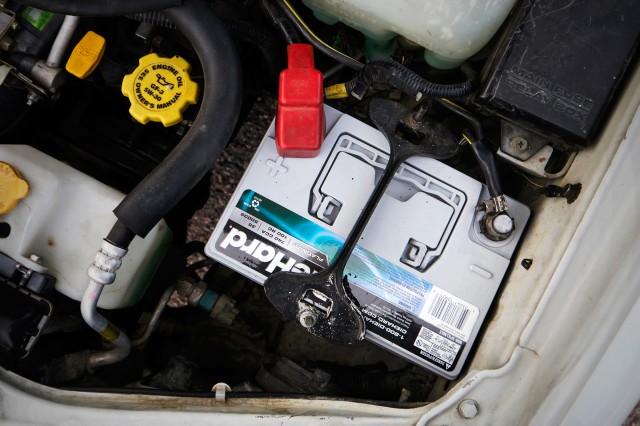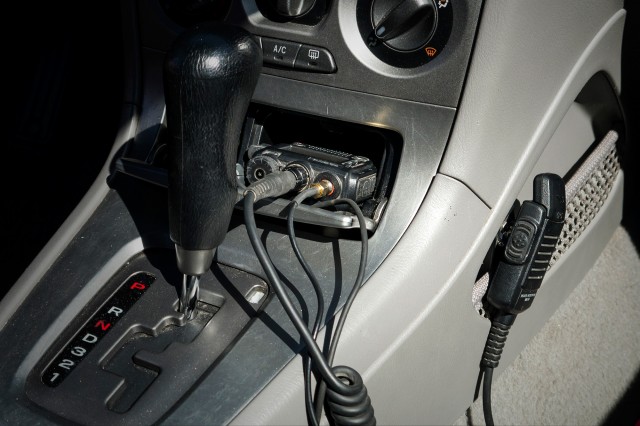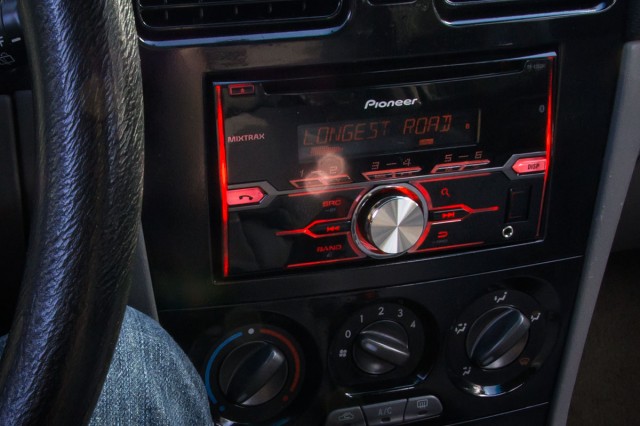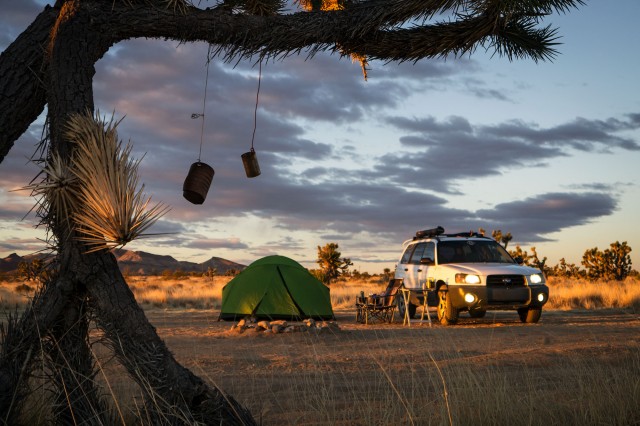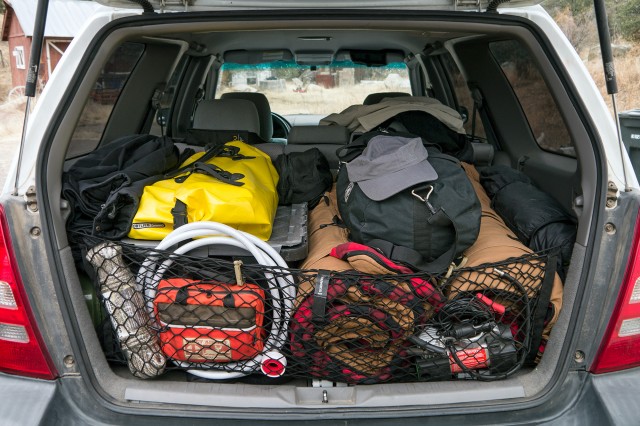The first time I packed up the Forester for an overnight camping trip the rear end sagged down to the bump stops, it clearly wasn’t the kind of “truck” I’m used to driving. Building this car has been a long lesson in keeping things simple and light. Though Subarus are built like Legos, modifications and cargo have to be carefully planned out to maintain a good balance between weight, handling, and power.
Mechanical Upgrades
The Forester’s brakes are adequate out of the box, but if you’re the type that enjoys long “spirited” drives through the mountains you might find them just a bit lacking. Brake fade is a particular endurance problem on the base model, which has drum brakes out back. Fortunately the fade can be minimized without the complexity of swapping in rear disc brakes. After looking at the Brembo option (which would have cost as much as the car itself), I decided to take a chance on the off-brand but highly praised Power Stop set of drilled and slotted rotors with high performance pads. The gamble paid off: for about $125 the brake fade is all but gone and the car now stops with confidence.
The only other mechanical weak point we’ve run into are the front CV axles. Fortunately, even with the suspension lift they’re good for at least 50,000 miles. At first blush that might sound nuts, but bear in mind they only cost $45 and about 2 hours of work to replace.
Electrical Upgrades
A 90-amp alternator comes standard in the Forester, which seems perfectly matched to any reasonable accessory load for a vehicle this size. We’ve had no trouble running a variety of accessories simultaneously, from air compressors to radio equipment, so we chose instead to focus on preventative and convenience upgrades.
First up was a DieHard Platinum Group 35 AGM battery (essentially an Odyssey PC1400) to replace the original lead-acid unit and ensure reliable power in the field. The DieHard features 850 cold cranking amps, plenty of reserve power for in-camp use, and a 4-year warranty. I love drop-in upgrades…
Next we addressed communications. Though surprisingly capable, the Forester is more about adventure outside the vehicle than inside, so we opted for the flexibility of a hand-held radio. The Yaesu VX-8R ruggedized handheld allows for the convenience of a mobile unit when pared with an external mic and antenna, while retaining a slim profile and light weight for hiking, biking, and canoeing. It’s also packed full of all the features from the nicer mobile units like dual transceivers and built-in APRS.
The speakers installed in the Forester from the factory aren’t completely horrible, but the stereo is one of the worst units I’ve ever used. Aux inputs hadn’t yet caught on in 2003, so our music selection was limited to the barely-functional radio or what few CDs we could track down. Adding insult to injury, you could actually hear the motors and the CD spinning through the speakers… the stock head unit had to go. In it’s place is a double-din Pioneer FH-X720BT: all the digital media connectivity one could want and decent sound reproduction for well under the $200 mark. The unit’s Bluetooth link is nearly flawless, but if you do remember to plug it in the USB port will also charge a phone. For additional accessory charging we also added a Bluesea dual USB charger in place of the cigarette lighter, bringing the total built-in power points to three USB and three standard 12VDC.
Camp and Sleeping
The Forester will handle the smaller roof tents on the market if one is so inclined, such as James Baroud’s Horizon Vision, with little impact on handling or fuel economy. Still, the car is much more suited to a ground tent and the traditional camp kitchen and furniture that goes with it. The best approach is to pack like you’re backpacking, then add a few luxury items like firewood, good chairs, and a sturdy table.
Water
At the moment we’re running an extra 5-gallon RoadShower we had in the shop as a gravity-fed water system. It works well, but it’s $300 price point makes it impractical for a budget project. A better option would be the off-brand Scepter clones which can be picked up for around $30 and nest nicely behind the rear passenger-side wheel arch. For a little extra convenience, Living Overland makes a self-contained 12-volt pump/faucet combo that drops right in place of the water can’s stock cap.
Cargo Handling
Despite external appearances, the Forester’s cargo space is quite impressive (high praise coming from the owner of a cavernous Discovery). There’s enough room inside that you’ll run out of weight capacity long before space. Though small, the tie-downs provided at all four corners are stout enough to handle as much weight as you’d want to carry in a Forester. The following photo shows enough food, water, and oversized cold weather gear for two people for three days along with tools, an emergency kit, and an extra 50 miles of fuel (2.5 gallons).
What isn’t visible above is the oversize Kelty loveseat tucked neatly behind the rear seat or the cast-iron cookware packed in the kitchen box. With more efficient gear choices, everything a family of four needs for a weekend camping trip could easily fit.
With the low roofline, bulky items like bikes and canoes are easy to carry up top. Be warned however, the factory cross bars are not up to the challenge of weight or sunlight: ours were actually crumbling when we removed them. Yakima and Thule both make excellent direct-fit, bolt-on options for securely handling roof cargo. Space the cross bars just right and a single ratchet strap is all you need to mount a pair of MAXTRAX.
The Budget
I’ve often been asked what the total costs have been on this build, and considering a main goal on this project is economy, it’s only fair to share the full accounting of what it took to reach this point. All prices are in U.S. dollars, naturally.
- Original vehicle purchase: $2,400 with a blown motor (running MY03+ Foresters can be had around $5,000)
- Rebuilt motor, along with miscellaneous replacement parts, sensors and repairs to get it running: $1,500
- Learning how to build a motor, and turn every little bolt on the Forester: priceless
- Yakima RAILGRAB roof bar kit: $135
- Primitive Racing “Full Body Armor Kit”: $410
- DieHard Platinum G35 battery: $250
- Ironman 35mm lift kit and subsequent alignment: $400
- Yokohama Geolandar A/T-S 215/70R-16 (set of 5 with road hazard): $600
- Power Stop brake kit: $125
- Pioneer FH-X720BT stereo and required wiring: $150
- Bluesea dual USB charger: $20
- Yaesu VX-8R radio, charger, mic, antenna: $200 (used)
- Adventure Medical Kits Sportsman Whitetail: $50
- MAXTRAX: $300
- MV-50 air compressor: $60
- 2.5-gallon Fuel Can: $30
- 5-gallon on-board water: $30 can, plus optional $105 12V faucet
- Miscellaneous tools and emergency kit: $90
- Total fully-outfitted, adventure-ready cost: $6,855
Even in it’s stock form, the Subaru Forester is fully capable of carrying a family safely on adventures while providing economical daily commuter duty around town. If you’re looking to set up a Forester on a limited budget, here’s our advice: start with the skid plates and a good set of tires, then add additional upgrades once you’ve found a real need. You’ll be surprised how far those two modifications will carry you.
This concludes the Expedition Portal Budget Overlander project, but the build-out of this Forester is just beginning…
Previously: Expedition Portal’s Budget Overlander Build Thread, Part I, and Part II




